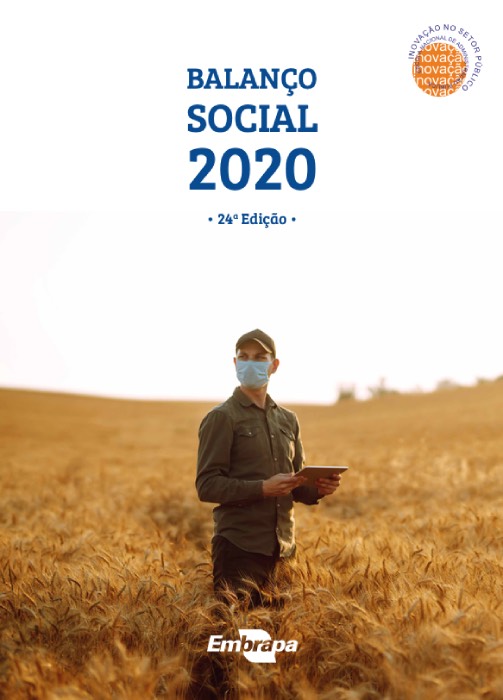Embrapa's Social Profit is R$61.85 billion in 2020
Embrapa's Social Profit is R$61.85 billion in 2020
Embrapa has just published another edition of its Social Report, with data for the year 2020. According to the publication, the company generated a social profit of R$61.85 billion last year. This value was reached through the analysis of the economic impact of a sample of 152 technologies and 220 cultivars developed by the company, in addition to labor and social indicators.
"Social profit is an amount derived from the economic benefits the production sector achieved with the adoption of technological solutions created by the company," says Graciela Vedovoto, analyst responsible for the Performance Assessment area of Embrapa’s Secretariat of Institutional Development (SDI). That amount is calculated through the sum of profits obtained by these solution adopters. "When we relate, in 2020, the R$61.85-billion social profit with the R$3.48-billion net operating income, we then have the social return rate of R$17.77 for each real invested in Embrapa,” Graciela details.
The analyst also clarifies that “in 2020 this ratio was particularly high because Embrapa went through a Severance Incentive Plan (PDI, from the acronym in Portuguese) and through a cost rationalization, which caused its budget to be reduced”, but she ponders: "this decrease in the formula's denominator is not common or frequent and it requires explanation that there were no atypical leaps in terms of research benefits, but a situation related to the company's management", Graciela concludes.
Historical contribution to society
These figures summarize, from the economic aspect, a series of the Company's contributions to society and are among the main results presented in the Social Report. Another important piece of data, also obtained through this sample of technological solutions, is the generation of 41,475 new jobs in 2020. The economic benefit provided to the production sector that incorporates Embrapa's research, in recent years, was much higher than the amount of financial resources invested in the Company.
These Social Report figures have gained a greater relevance with the emergence and worldwide spread of the COVID-19 virus. The pandemic has challenged several countries to deal with its consequences, including in terms of food security. According to Celso Moretti, Embrapa's president, "Embrapa's contribution to face the pandemic was not only immediate, in making its laboratories available to produce virus identification tests, among other initiatives; but also in reality, the technological solutions that Embrapa and its partners have generated for the last decades have provided the Brazilian population with access to food in quantity, quality and at cheaper prices. That historical performance makes all the difference at times like this.” Even with the pandemic, Embrapa continued to greatly contribute to the Brazilian society's quality of life.
New paths and contributions
In addition to its historical contribution that have reached the present day, 2020 was the year that the Company paved new paths and redirected its action with the launch of the VII Master Plan, and it re-evaluated its research programming and improved the alignment between its innovation process and the Sustainable Development Goals (SDGs) established by the United Nations. As if these new challenges and perspectives were not enough, Embrapa presented a series of other results in 2020.
Among them, the Company contributed with sustainable technologies to the mitigation of climate change effects through the Low Carbon Agriculture Plan, a ten-year-old international initiative; Embrapa created SpeciFIT, a nuclear magnetic resonance equipment for the analysis of raw materials and food products; adapted a method for the regeneration of woolly jelly palms, a typical plant formation from the South of Brazil, whose wood, leaves and fruits provide an increase in income; and it promoted, alongside other institutions, studies about the Brazilian pine, to encourage cultivation of this forest species, which has seeds of high nutritional value and high-quality wood. In addition, the absence of forage species that are adapted to the Southern Region of Brazil was solved through a public-private partnership involving several Embrapa units co-responsible for the launch of 13 forage cultivars in the last twelve years.
At the consumer level, Embrapa contributed with the elaboration of a new standard on nutritional food labeling, making information much more transparent. Regarding information, the Zarc Plantio Certo mobile app, also created by the corporation, started facilitating the consultation of various data generated by the Agricultural Climate Risk Zoning (Zarc) and informing decision-making regarding the planning and execution of activities in the field. Moreover, even during a pandemic, production and consumption of information produced by Embrapa did not decrease. On the contrary, the cancellation of in-person events due to the COVID-19 outbreak has given great impetus to the corporation's online courses, events, and conferences in 2020. Distance Learning courses, for example, recorded 411,055 registrations last year, a growth of 1,411% from the 27,197 enrolled in 2019.
With all these results and prospects of action, the year 2020 showed that a major world crisis is not enough to demobilize an entire material and intellectual estate that has been built for over 48 years. Even in an unfavorable context, Embrapa rose up to the scenarios that were being presented.
Wilson Correa (MTb 121/MS)
Secretariat of Institutional Development (SDI)
Press inquiries
wilson.fonseca@embrapa.br
Translation: Raquel Porlan, supervised by Mariana Medeiros (013044/DF)
General Secretariat
Roberto Penteado (MTb 220/DF)
Secretariat of Institutional Development (SDI)
Press inquiries
roberto.penteado@embrapa.br
Further information on the topic
Citizen Attention Service (SAC)
www.embrapa.br/contact-us/sac/

